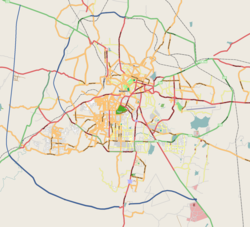
Kempe Gowda I locally venerated as Nadaprabhu Kempe Gowda, or commonly known as Kempe Gowda, was a governor under the Vijayanagara Empire in early-modern India. He is famous for the development of Bangalore Town in the 16th century. Kempegowda erected many Kannada inscriptions across the region.

Yelahanka is a premium locality in north Bangalore and also a Taluk of Bangalore Urban district in the Indian state of Karnataka. One of the zones of BBMP. It is the oldest part of present Municipal Bengaluru (Bangalore) city and the northern end of the city. It is Nadaprabhu Kempegowda I, of the Yelahanka Prabhu clans, who laid the foundation of present-day Bengaluru through the creation of a "mud fort town" in 1537 CE

Bruhat Bengaluru Mahanagara Palike (BBMP) is the administrative body responsible for civic amenities and some infrastructural assets of the Greater Bengaluru metropolitan area. It is the fourth largest Municipal Corporation in India and is responsible for a population of 8.4 million in an area of 741 km2. Its boundaries have expanded more than 10 times over the last six decades.
Greater Bengaluru is a metropolitan area in the state of Karnataka and it including Bangalore as well as its neighbouring urban cities. It occupies an area of 741 sq km.
Puttenahalli WS Lake also spelled as Puttanahalli Lake is a 10-hectare water body near Yelahanka, 14 km north of Bangalore.

Padmanabhanagar is a residential locality in South Bangalore, India, covering an area of 1.68 km2. It is one of the zones of BBMP. Padmanabhanagar has a very famous park called Lakshmikanta Park. This park houses Lakshmi Kantha temple. It was looked after by residents association, in 2018 the corporator allotted funds and developed it further. The park was eyed for its medicinal trees and was sanctioned to be cut down completely and set up a landscaped area but the senior citizens of the locality who nurtured the park protested and stopped it. It is surrounded by Kumaraswamy Layout, Gowdanapalya, Chennamanakere, Kathriguppe, Kadirenahalli, Uttarahalli and Chikkakalasandra.
Sahakara Nagar is a residential suburb near Bangalore, India. Sahakanagar is formed by the Ministry of Communication Employees housing society and has developed to this extent under the efforts of the Sahakaranagar Residents welfare association. Ever since the inclusion of 45 new wards to Bangalore city in 2008, Sahakara Nagar comes under the BBMP limits. The locality is accessible via NH 7 on the East. Sahakara Nagar was formed in the early 1980s as a co-operative society for Telecom and Post & Telegraph employees of the Government of India. It has over 8 well maintained parks and two Playgrounds maintained by BBMP. Owing to its proximity to Hebbal lake, Amrutahalli lake and GKVK forest land, it is often called the Prague of Bengaluru city.

Garuda Mall is the premier shopping mall in the city of Bangalore, India, which is also home to the city's second oldest Shoppers Stop branch, and the oldest one in the city which is attached to a mall. It is situated on Magrath Road at the heart of the central business district in Bangalore, near Brigade Road. The mall has opened another branch in the Heritage City, Mysore near K. R. Circle. Another branch in Kochi with French cuisine and heritage.
Yelahanka Lake is a water body near Yelahanka, a suburb of Bangalore.
Bharathnagar is a well planned residential layout in the city of Bangalore, India. Located off the arterial Magadi Road and approximately 13 km (8.1 mi) from the Bangalore Central Railway station, this layout was primarily created for the employees of the public sector giant Bharat Electronics Limited. Bharathnagar is divided into Phase 1 & 2. Phase 2 is the larger of the two and has the capacity to accommodate 4000 independent homes, whereas Phase 1 can accommodate 2,000 homes. Bharathnagar was carved out of the larger village of Byadarahalli.

Mayo Hall is a government building located in the center of Bangalore. It was built to honor the memory of Lord Mayo, the 4th Viceroy of India. It offers a panoramic view of the city's Parade Grounds and Ulsoor Lake on one side, and the Bangalore Race Course and Brigade Grounds on the south.
Brookefield is a neighbourhood of Bangalore. It was established in the late 19th century as a settlement for the Eurasians of Bangalore. It is a wealthy area, with high real estate prices and relatively new commercial roads such as ITPL road.
Gandhi Nagar is a locality situated in Bangalore. It is a bustling neighbourhood of Central Bangalore.
In 2007, for administrative purposes, the city of Bangalore was divided into nine zones, which were further subdivided into a total of 198 wards administered by the Bruhat Bengaluru Mahanagara Palike (BBMP). After delimitation in 2023, BBMP increased the number of wards to 225.
The Kempegowda Award or Nadaprabhu Kempegowda Award is a civilian award presented annually by Bruhat Bengaluru Mahanagara Palike (BBMP), Bengaluru, Karnataka, India.

Yelahanka Ward, officially known as Kempegowda Ward is one of the 225 Wards of Bruhat Bengaluru Mahanagara Palike, an administrative body responsible for civic amenities and some infrastructural assets of the Greater Bangalore metropolitan area in the Indian state of Karnataka.

The 2015 Bruhat Bengaluru Mahanagara Palike election was held on 22 April 2015 in all 198 Wards of Bangalore (Bengaluru).

Chowdeshwari Ward, is one of the 198 Wards of Bruhat Bengaluru Mahanagara Palike, an administrative body responsible for civic amenities and some infrastructural assets of the Greater Bangalore metropolitan area in the Indian state of Karnataka.

Attur Ward, is one of the 198 Wards of Bruhat Bengaluru Mahanagara Palike, an administrative body responsible for civic amenities and some infrastructural assets of the Greater Bangalore metropolitan area in the Indian state of Karnataka.













